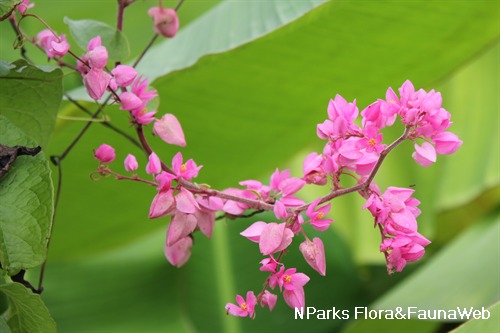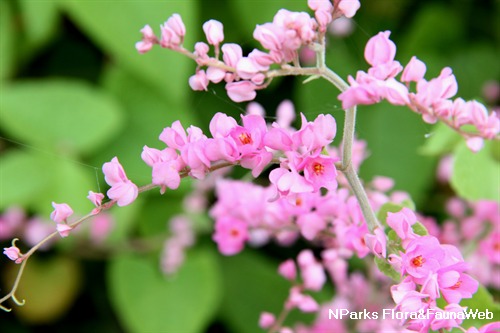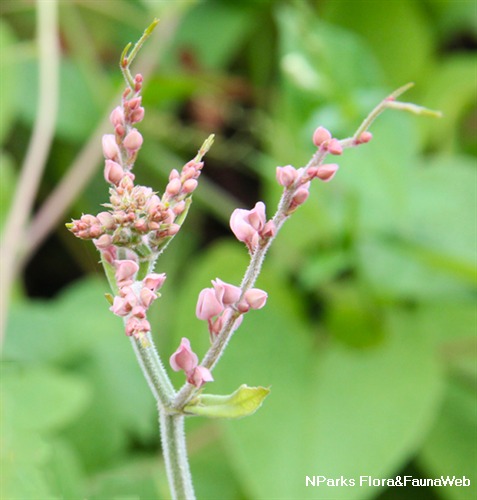
Back
Antigonon leptopus Hook. & Arn.
| Family Name: | Polygonaceae |
| Common Name: | Coral Vine, Mountain-rose Coralvine, Rosa de Montana, Bellísima, Corallita, Bunga Bonet, Bunga Berteh, Honolulu Creeper, Confederate Vine, Mexican Creeper, Coral Creeper, Chain of Love, Hearts on a Chain, Love Vine, Queen's Wreath, 珊瑚藤, 朝日藤 |
The Coral Vine ( Antigonon leptopus ) is a fast-growing climber with heart-shaped leaves. It has vibrant pink flowers and is a prolific bloomer under bright sunlight. The flowers are rich in nectar that attract bees and butterflies. This lush climber is best supported on trellises as it can form a dense canopy that provides shade. Cultivated varieties of the Coral Vine come with white or dark red flowers.
Name
Classifications and Characteristics
| Plant Division | Angiosperms (Flowering Seed Plants) (Dicotyledon) |
|---|---|
| Plant Growth Form | Climber |
| Lifespan (in Singapore) | Perennial |
| Mode of Nutrition | Autotrophic |
| Plant Shape | Irregular |
| Maximum Height | 9 m to 12 m |
| Maximum Plant Spread / Crown Width | 6 m |
Biogeography
| Native Distribution | Mexico |
|---|---|
| Native Habitat | Terrestrial |
| Preferred Climate Zone | Tropical, Sub-Tropical / Monsoonal |
| Local Conservation Status | Non-native (Spontaneous (Casual)) |
Description and Ethnobotany
| Growth Form | Herbaceous slender-stemmed vine, climbs with tendrils arising from ends of inflorescence. Heat and drought-tolerant when established. Fast-growing and quickly covers walls, trellis and arbors with lush foliage. In Singapore, plant may have a tendency to produce flowers only towards top of growth. |
|---|---|
| Foliage | Leaves soft, narrowly heart-shaped, light green, prominently-veined with wavy margins. Leaves are alternately arranged along the stems, simple and borne on petioles (stalks) that are 1 - 5 cm long. |
| Stems | Stems are slender, climbing onto other vegetation via tendrils that are borne on leaf axils. |
| Flowers | Flowers bright pink, fragrant, produced as cascading racemes, attractive to bees and butterflies. Each flower has 5 petals with entire margin with acute tips, 8 stamens and 3 styles and stigmas. The flowers will turn dull pink and eventually brown as they age. |
| Fruit | Brown achene, cone-shaped or three-angled, shiny in appearance. The fruits are usually hidden within the enlarged persistent petals. |
| Habitat | Found in thickets, rainforest margins, coastal areas, roadsides, disturbed sites and gardens. |
| Cultivation | Can easily grow on well-drained soils in full sun. Tolerates drought when established but appreciates moisture during growing season. |
| Etymology | The genus Antigonon means opposite-angled, which refers to the zig-zag stems of coral vine. The specific epithet leptopus means slender stalks. |
| Ethnobotanical Uses | Food (Fruit or Vegetable): Underground tubers cooked and eaten in native Mexico for their nutty flavour. (Herb or Spice) Medicinal: Leaves used in the Caribbean as poultices for boils and swellings. Tea made from leaves used to treat high blood pressure, diabetes, flu and menstrual pains. Cut - Dried Flower: Flowers used in bridal bouquets in parts of Southeast Asia, or made into wreaths by children during play-time. |
Landscaping Features
| Desirable Plant Features | Ornamental Flowers |
|---|---|
| Landscape Uses | Vertical Greenery / Green Wall, Trellis / Arbour / Pergola, Container Planting |
| Thematic Landscaping | Butterfly Garden, Naturalistic Garden |
Fauna, Pollination and Dispersal
| Fauna Pollination Dispersal Associated Fauna | Butterfly-Attracting (Flower Nectar, Flower Pollen), Bee-Attracting |
|---|---|
| Pollination Method(s) | Biotic (Fauna) (Insects (Butterfly, Moth), Insects (Bee)) |
Plant Care and Propagation
| Light Preference | Full Sun |
|---|---|
| Water Preference | Little Water, Moderate Water |
| Plant Growth Rate | Fast |
| Rootzone Tolerance | Fertile Loamy Soils, Well-Drained Soils, Alkaline high pH Soils, Drought Tolerant |
| Potential Problems | No serious insect or disease problems. Caterpillars may chew on the leaves. |
| Propagation Method | Seed, Stem Cutting, Storage Organ |
| Maintenance Requirements Remarks | Plant may have tendency to flower only towards top of growth. |
Foliar
| Foliage Retention | Evergreen |
|---|---|
| Mature Foliage Colour(s) | Green |
| Mature Foliage Texture(s) | Velvety / Furry / Tomentose, Raised / Sunken Veins |
| Prominent Young Flush Colour(s) | Pink |
| Foliar Modification | Foliar Tendril |
| Foliar Type | Simple / Unifoliate |
| Foliar Arrangement Along Stem | Alternate |
| Foliar Attachment to Stem | Petiolate |
| Foliar Shape(s) | Non-Palm Foliage (Ovate, Cordate) |
| Foliar Venation | Pinnate / Net |
| Foliar Margin | Entire - Wavy / Undulate |
| Foliar Apex - Tip | Acuminate, Acute |
| Foliar Base | Cordate |
| Typical Foliar Area | Mesophyll ( 45cm2 - 182.25 cm2 ) |
Non - Foliar and Storage
| Stem Type & Modification | Herbaceous |
|---|---|
| Root Type | Underground (Fibrous Root) |
| Specialised Storage Organ(s) | Underground (Root Tuber) |
Floral (Angiosperm)
| Flower & Plant Sexuality | Bisexual Flowers |
| Flower Colour(s) | Pink |
|---|---|
| Flower Texture(s) | Smooth |
| Flower Grouping | Cluster / Inflorescence |
| Inflorescence Type | Raceme |
| Flowering Period | Free-Flowering |
| Flowering Habit | Polycarpic |
Fruit, Seed and Spore
| Mature Fruit Colour(s) | Brown |
|---|---|
| Fruit Classification | Simple Fruit |
| Fruit Type | Indehiscent Dry Fruit , Achene |
Image Repository
Others
| Master ID | 16 |
|---|---|
| Species ID | 1312 |
| Flora Disclaimer | The information in this website has been compiled from reliable sources, such as reference works on medicinal plants. It is not a substitute for medical advice or treatment and NParks does not purport to provide any medical advice. Readers should always consult his/her physician before using or consuming a plant for medicinal purposes. |













.jpeg)
.jpeg)
.jpeg)
.jpeg)
